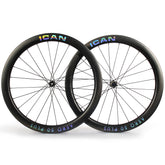Choose the Best Gravel Handlebar 2024 – A Buying Guide
What is the difference between road bike and gravel bike handlebars?
If you're looking for better control and stability when cycling off-road, consider switching from traditional road handlebars to off-road handlebars.
The main difference between road bike and off-road bike handlebars is the bulge in the handlebars. Standard road bike handlebars are designed for optimal speed and efficiency. In contrast, wider handlebars with outwardly curved bar ends offer better control of the bike.
Wider handlebar width can create a more comfortable position for most people, especially mountain bikers, and provide more stability and leverage when climbing and descending the hoods. When driving on steep, loose, downhill or technically demanding routes, most drivers keep their hands in the handlebar ends. Flatter, flared and outwardly curved drop extensions offer more control in this position.

Photo credit: https://bikepacking.com/
Here are the most important dimensions for the gravel handlebar:
- FLARE refers to the angle at which the drops rotate outward from front to back on an axis parallel to the hoods. The flare is considered beneficial because it causes the hands to spread wider in the drops, allowing for a better position for support and better control on rough terrain.
- REACH refers to the distance between the handlebars and the stem clamping area. A longer reach (>80mm) puts the rider in a more aggressive and aerodynamic stance in the drop position, suitable for higher speeds. On the other hand, a shorter reach (<75mm) is more comfortable and provides better control when riding off-road and on unpaved surfaces.
- DROP is the distance between the horizontal stem clamp and the lower end of the handlebar extension. A larger drop (>120mm) puts the rider in a more aerodynamic position, while a smaller drop (<120mm) is more comfortable and makes entry and exit easier. It's also important to note that many modern gravel bars have a less rounded "hook" shape to create a dominant drop grip.
- WIDTH is the distance from hood to hood. Some brands indicate this value on the outer edges, which would make the handlebar narrower than a handlebar of the same value when measured from C to C.
How much scattered light is best?
The answer to the question of whether you should choose wider or narrower handlebars for your gravel bike depends on your riding habits. If you prefer wider handlebars, your hands will be further apart when riding the drops. This gives you more influence over the front wheel, which helps you control the bike better. However, wider handlebars may not be as comfortable on long rides as they can tire your hands.
If you tend to ride on challenging terrain with short descents, wider handlebars may be a good choice for you. They offer you better control of the bike, which is essential in such situations. However, if you prefer riding in quieter terrain at high speeds and long descents, narrower handlebars may be a better choice. They help you get into a more comfortable position and are more aerodynamic, allowing you to spend more time in the drops.
Which handlebar width should I choose?
When choosing handlebars for your gravel bike, we recommend choosing the same size or one size wider than your racing bike. For example, if your road bike is a 42, you can choose a 42 or 44. The additional width ensures more space and therefore more driving comfort. Plus, the extra width improves handling and allows you to ride more aggressively.
It is important that you are aware of widening, which can increase the overall width by 50mm or more. If you often ride your gravel bike on single trails or through narrow passages, you should pay attention to the size.
If you intend to build a gravel bike specifically for racing, you can stick to the same width as your road bike. When you're narrower, you're more aerodynamic.
But it is also possible to be too wide. If your hands are too far below your shoulders, you will have to use more energy to support yourself, which will cause you to tire more quickly.
Carbon fiber vs. aluminum handlebars
Carbon fiber has several advantages over aluminum, the most important being lighter weight. By switching to carbon handlebars you can save up to 40-50 grams.
Another advantage of carbon is its ability to reduce vibration. Aluminum transmits the vibrations of the road easily, but carbon is better at absorbing them, so fewer vibrations reach your hands.
Weight and vibration aren't the only benefits of carbon fiber bike frames. There are other subtle benefits too. Carbon fibers allow for the creation of complex shapes and precise tuning of the bend. This enables the creation of aerodynamically optimized profiles. Even if you're not overly concerned with weight, carbon fiber is worth considering.
Can I use gravel handlebars on my road bike?
Gravel handlebars can provide additional comfort for most cyclists, regardless of the type of bike they use. Even if you have a road bike, it's worth considering gravel handlebars for added comfort. Don't feel limited by labels or rules.For more information on road bike handlebars, see the Road Bike Handlebars Guide.






